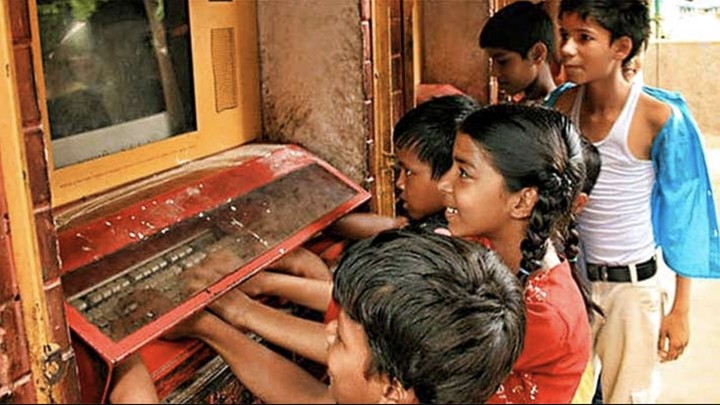Digital Village Squares
 Children at an ATC learning station. Photo credit: Wireless Estimator.
Children at an ATC learning station. Photo credit: Wireless Estimator.Executive Summary
Digital Village Squares is an Indian corporate social responsibility initiative implemented by American Tower Corporation in collaboration with the NIIT Foundation and Hole in the Wall Education Limited (HiWEL). HiWEL learning stations and digital literacy training classes by the NIIT Foundation are now available at 51 Squares in rural India. Students can engage in self-paced interactive learning through the learning stations, and adults are trained in basic computer skills using the National Digital Literacy Mission’s curriculum at these locations.
Keywords: digital literacy training, education, rural, India
Context
India’s population of over 1.3 billion people suffers from acute challenges in traditional and digital literacy. To address this gap and enable adoption of services provides using Internet connectivity, the Government of India started the National Digital Literacy Mission (NDLM) in 2011. The mission aims to partner with non-governmental organizations and corporate social responsibility initiatives to deliver training programs to a range of students, youth and adult learners. The Digital Literacy Mission’s vision is to create a multi-stakeholder consortium that can work to showcase the transformative impact of digital literacy on governance, employment, social inclusion and empowerment.
The NDLM seeks to complement the objectives of National Optic Fibre Network (NOFN)—now Bharatnet-- plan to transform every household by educating one adult from each household in India.
Further, there is a “Digital India” initiative that seeks to transform and digitize the Indian economy that spans various sectors, including e-governance and financial inclusion initiatives that leverages ICTs.
India
| Population (UN, 2015) | 1,282,390,303 | Fixed broadband subscriptions (%) (ITU, 2016) | 1.44 |
| Population density (people per sq.km) (UN, 2015) | 390.11 | Mobile cellular subscriptions (%) (ITU, 2016) | 86.95 |
| Median household income (Gallup, 2006-2012) | US$ 3,168 | Individuals using the Internet (%) (ITU, 2016) | 29.50 |
| Education (Mean years of schooling) (UNDP, 2013) | Male: 5.6 Female: 3.2 | Individuals using the Internet by Gender (%) (ITU, 2016) | N/A |
Project Description
Digital Village Squares are locations in rural India that are either adjoining tower sites or at local schools, where digital literacy training occurs. The initiative is part of American Tower Corporation’s corporate social responsibility efforts in India, and seeks to advance the Digital India vision. American Tower partners with Hole-in-the-Wall Education Limited and the NIIT Foundation to implement this initiative.
The sites for Digital Village Squares are carefully chosen in locations that are central to villages. After a pilot was run in a few villages, community buy-in proved to be a strong determinant of the success of the program. A comprehensive mobilization plan is therefore used to create awareness about the training and services offered at the center. Pamphlets, skits, and sessions at the Gram Sabhas are held to reach as many people as possible. Children enrolled in schools have also proven to be helpful in spreading awareness about the project within their communities. The trainers recruited for imparting digital literacy training are all local to the areas where these Squares are located.
A sense of ownership also plays a role in whether there is increased use of these learning stations and classes. When learning stations were installed adjacent to tower sites, initially, there was more engagement at those locations than in schools. Continued engagement with school administrations to emphasize the utility of these learning stations has led to better uptake and use. At the training classes, the National Digital Literacy Mission’s curriculum is taught over the course of 20-25 days, at the end of which an assessment of ICT skills is administered by the trainer.
The program hopes to evolve to cover a wide range of e-governance services and engage local entrepreneurs in key ways to maintain these sites, as a means to enhance long-term sustainability.
Project Details
| Technology | Learning stations for digital literacy for children | Training | In-person digital literacy training at village squares |
| Year program started | 2016 | Cost to users | Free |
| Geography | Rural | Total cost of program | Undisclosed |
| User profile | Elementary school students, low income communities | Associated Organizations | NIIT Foundation |
Progress and Results
The Digital Village Squares are presently available in 51 sites all in rural areas, with 28 that are standalone HiWEL stations, and 23 that offer digital literacy training using the National Digital Literacy Mission’s curriculum. The demand for training has seen a rise in these locations, evidenced by long queues for classes at the Squares.
Challenges
Coordination challenges – Selecting sites for Digital Village Squares that are self-sustainable over the long term was a key consideration in the deployment of this project. Sites chosen were centrally located, either within a village or at the intersection of villages, to enable greatest access to the local population. Neutrality of the location was also of importance, and a conscious effort to avoid religious and culturally sensitive sites.
Lack of skilled manpower – Partnerships with non-governmental organizations to impart relevant training at these locations, and enhance usability of interfaces to further interactive learning was another goal that the project sought to achieve. Leveraging the right partnerships to advance the goals of usability and ease of access has been a challenge.
American Tower’s Suggestions for Future Projects
A sense of ownership and community buy-in is key to success of digital literacy training programs in remote, rural areas – American Tower notes the relevance of local trainers, as well as fostering community partnerships. Sustainability of these sites over the long term can be enhanced by locally recruiting trainers and creating partnerships within the local community for the maintenance and use of these sites.
Innovative outreach mechanisms can help – American Tower uses pamphlets, skits, Gram Sabha sessions to help build a rapport with these communities.
Sources
Aggarwal, S. (2017, April 1). Personal Interview.